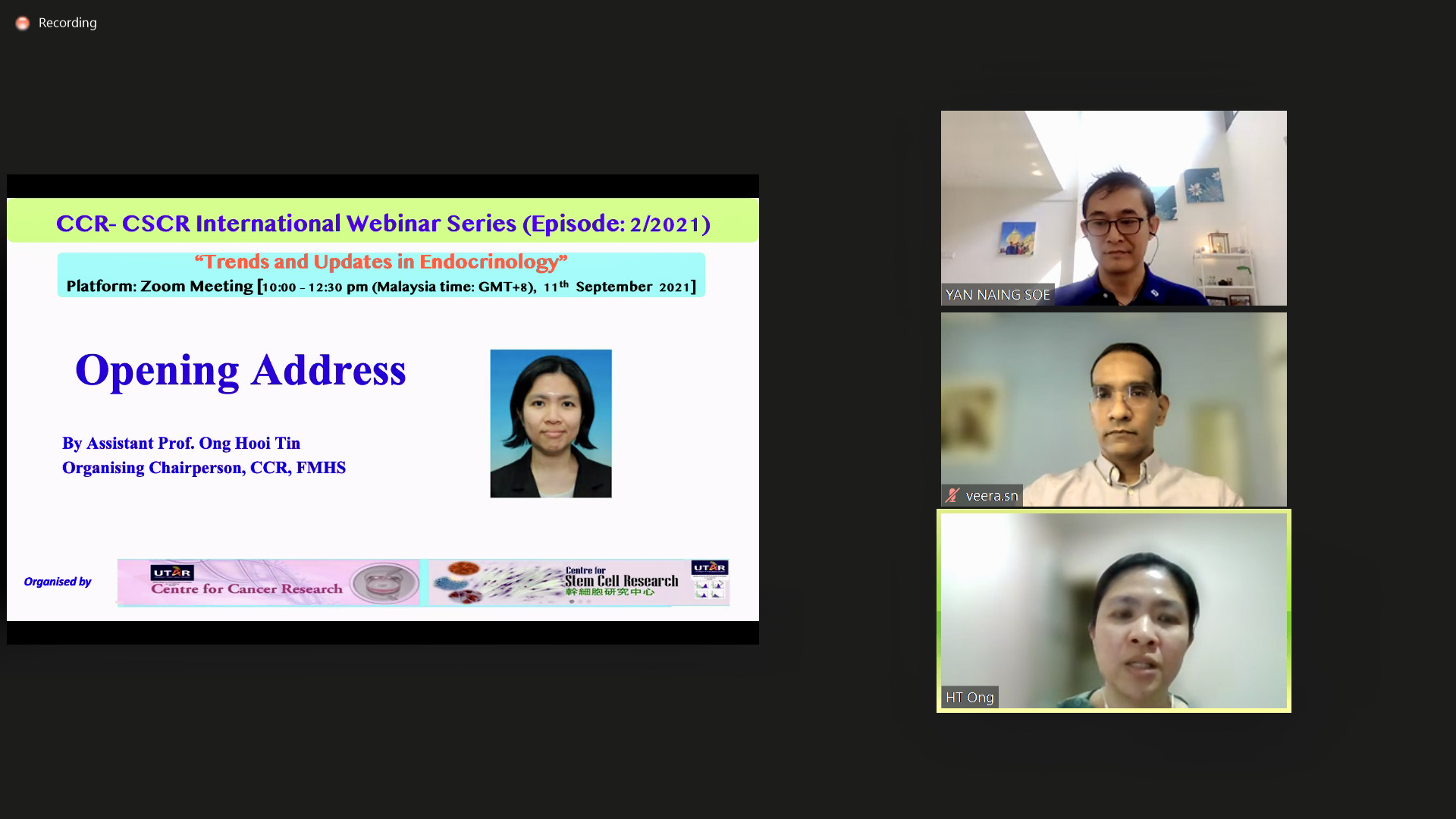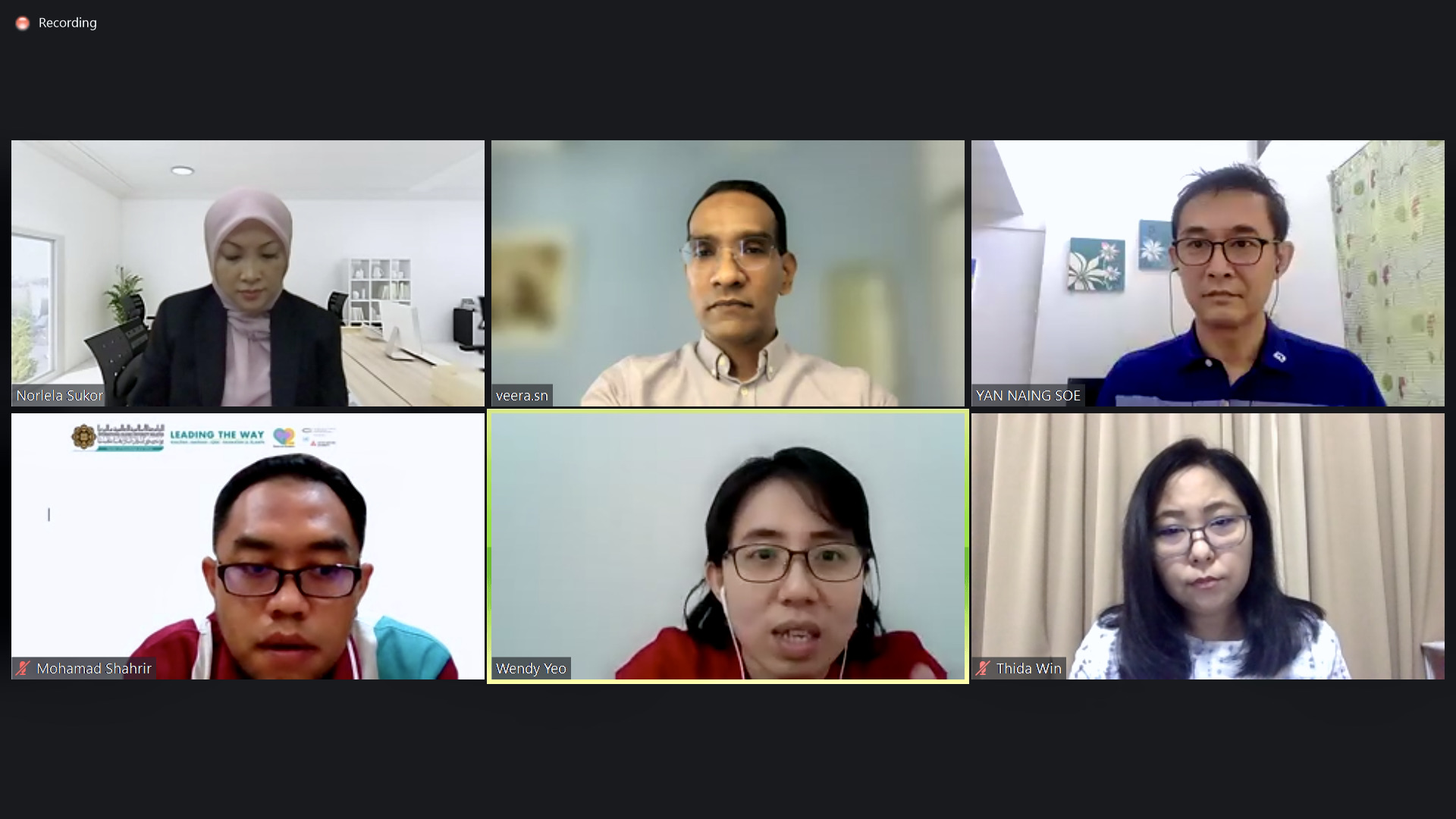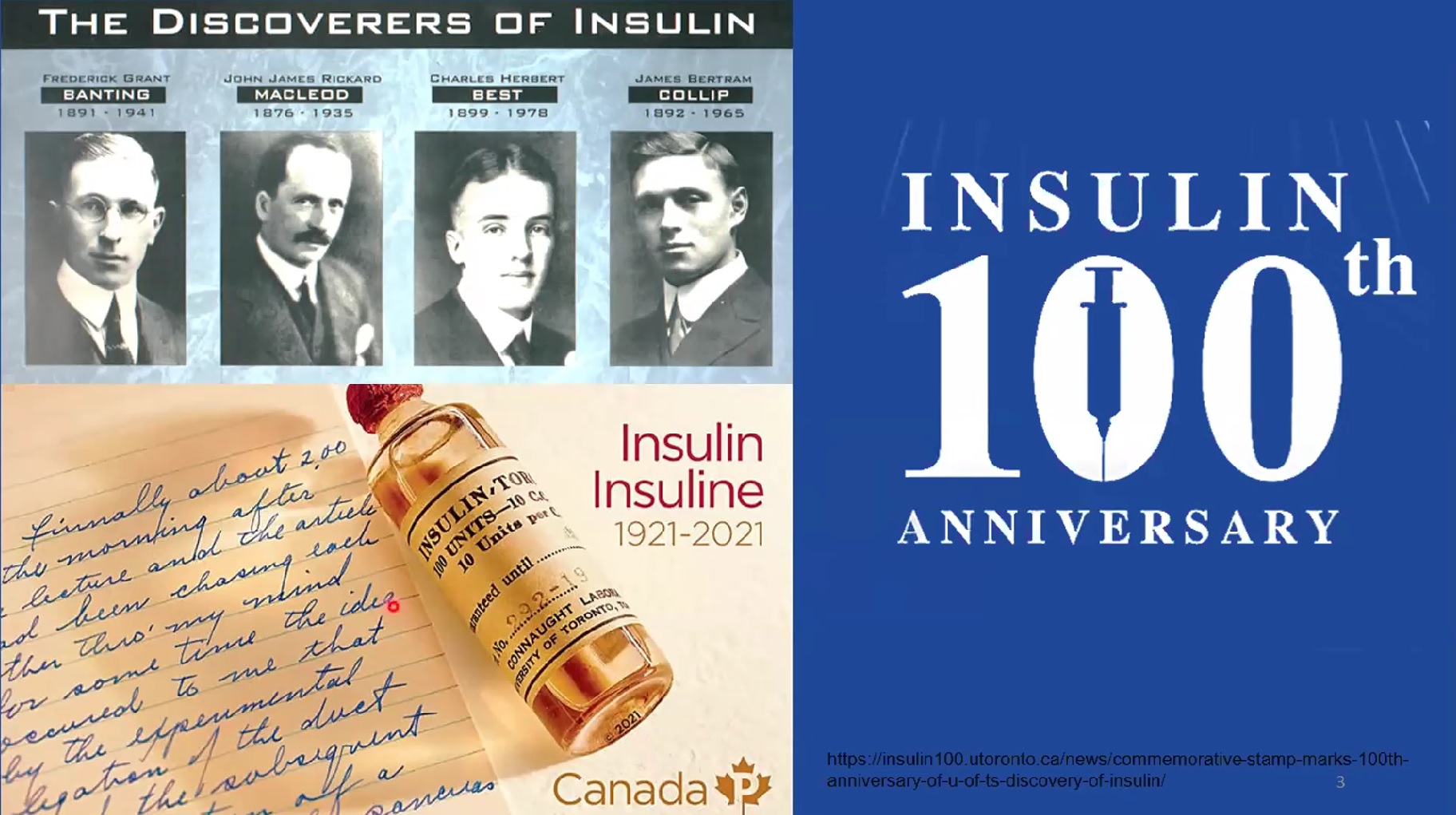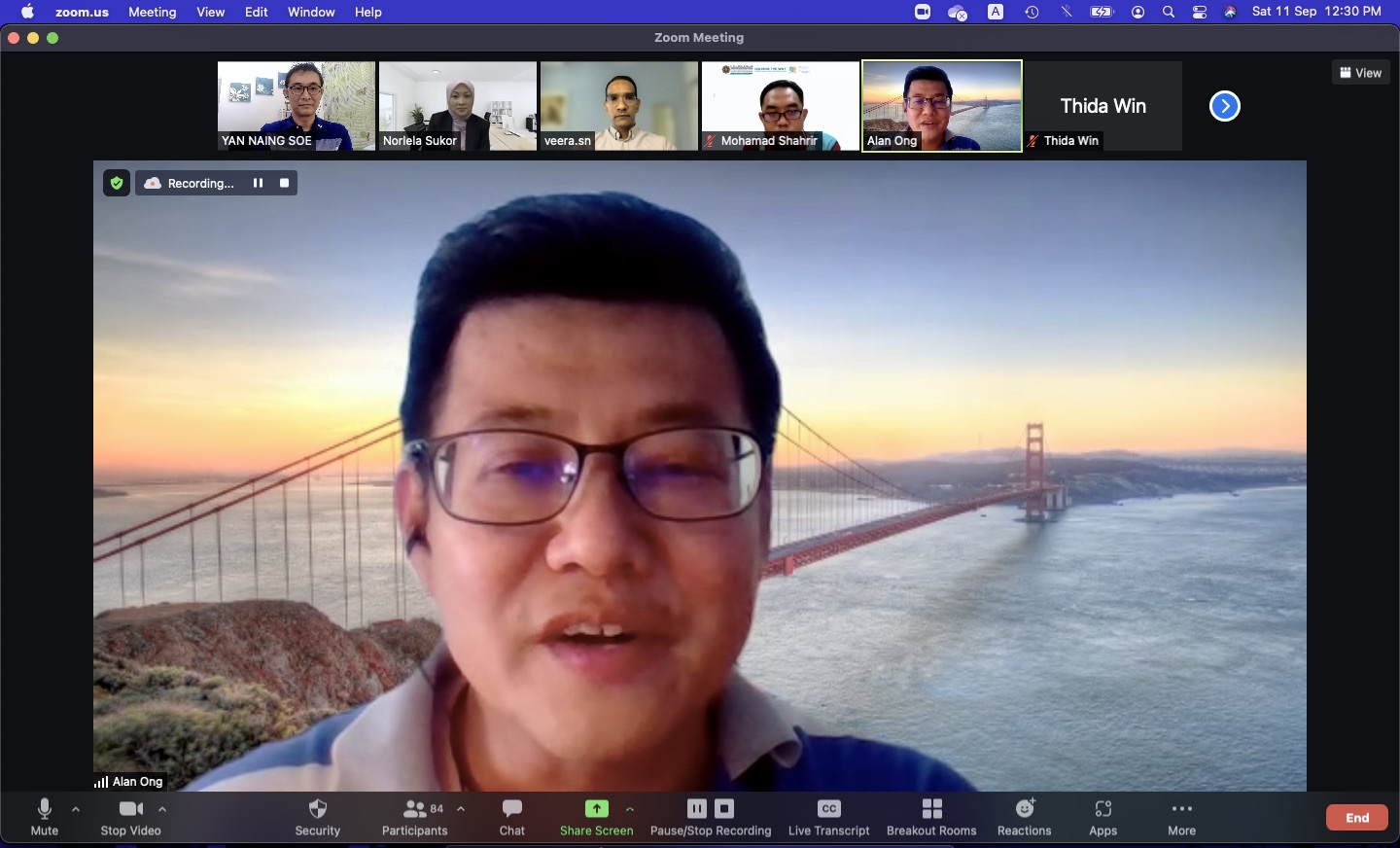

The webinar provides an ideal platform to share expertise in endocrinology
An international webinar titled "Trends and Updates in Endocrinology" was jointly organised by UTAR Centre for Cancer Research (CCR) and Centre for Stem Cell Research (CSCR) via Zoom on 11 September 2021.
The webinar, covering both the clinical and research aspects of the endocrinology area, was comprised of presentations from four presenters. It was followed by Q&A discussion sessions where participants submitted their questions to the expert speakers for discussion. The webinar was moderated by UTAR Faculty of Medicine and Health Sciences (FMHS) Prof Dr Veera Sekaran Nadarajan and Clinical Assoc Prof Dr Yan Naing Soe.

Dr Ong (most bottom) giving her opening address
The webinar began with opening remarks by CCR Chairperson Dr Ong Hooi Tin to welcome all the speakers and participants. In her remarks, she said, “I believe most of us here know that endocrinology is a field related to hormones. The way the hormones work or do not work contributes to some of the major diseases, for example, diabetes, thyroid diseases and cancers. In this webinar, we are fortunate to have four researchers and clinicians to speak to us on this key theme.”

From top left, clockwise: Prof Dr Norlela, Prof Dr Veera Sekaran, Assoc Prof Dr Yan, Dr Thida Win, Dr Wendy Yeo and Dr Mohammad Shahrir
The first presentation titled “Stem Cells as Potential Therapy in Diabetes Mellitus” was delivered by Dr Wendy Yeo Wai Yeng, a lecturer from Perdana University Graduate School of Medicine. “What we eat and how much we eat have a big impact on the blood glucose in our bodies,” she said. She explained that glucose is the main source of energy for our cells and bodies, and deficiency in the production of insulin—a hormone made by the pancreas will lead to diabetes mellitus, causing blood glucose levels to become abnormally high.
“There are two types of diabetes mellitus. The first one is type 1 diabetes, where our body immune system attacks and destroys beta cells. On the other hand, type 2 diabetes is where our beta cells lose the ability to produce or release enough insulin,” Dr Wendy Yeo explained. She also shared the general strategies for treating diabetes mellitus, and further explained the role and the types of stem cells. She explained the two main challenges faced by patients with diabetes mellitus and shared the strategies of using stem cells for the treatment of the disease.

Dr Wendy Yeo sharing that this year marks the 100th anniversary of the discovery of insulin (1921-2021)
The webinar continued with a presentation on the “Role of Radioiodine in Management of Thyroid Cancer” by Head of Nuclear Medicine Centre Dr Mohammad Shahrir bin Abdul Rahim from International Islamic University Malaysia (IIUM). He first shared the history of the discovery of radioactive iodine and its early use in studies of thyroid function. He mentioned that radioiodine treatment for hyperthyroidism was not widely adopted in 1945 by the end of the war partly because there was a shortage of supply for radioiodine and the medical therapy for hyperthyroidism, antithyroid drugs, had been invented. “Later, fission-derived radioiodine became readily available and has been used largely to treat patients. Initially, they were used to treat hyperthyroidism and later for thyroid malignancy,” he said.
He then explained Iodine-131, the radioiodine used for the management of thyroid cancer, and further explained the four types of Thyroid Carcinoma (Thyroid CA). “Radioiodine in Thyroid CA is the cornerstone for treatment of differentiated thyroid cancer. Until now, there is no role in treating Medullary and Anaplastic Thyroid CA with radioiodine,” he said. He also presented a patient’s journey in managing thyroid cancer and shared some important points from 2015 American Thyroid Association (ATA) guidelines.
Dr Thida Win, a senior consultant radiologist in KK Women's and Children's Hospital (KKH), Singapore, gave her presentation on “Sonographic Evaluation of the Thyroid Lesion”. “Thyroid nodules occur in up to 50% of the adult population. Palpable thyroid nodules occur in up to seven per cent of the population and Malignancy occurs in five to seven per cent of all thyroid nodules,” she said. According to her, thyroid nodule and thyroid malignancy are common in female predilection with the ratio of 4:1 and 2 to 3:1 respectively; while the probability of malignancy is higher for men and patients under 15 years or over 45 years of age. She also mentioned that mortality from thyroid cancer increases when the patient is over 45 years old.
Besides, she explained the diagnostic role of ultrasonography (US), computed tomography (CT) and magnetic resonance imaging (MRI), as well as positron emission tomography. “MRI and CT provide anatomic information regarding the position of the thyroid relative to adjacent vascular and muscular structures. MRI generally has superior contrast resolution and CT has a better spatial resolution. But US remains the best modality for the evaluation of nodules. The US is widely available and cost-effective,” she said. She also shared the common benign and malignant lesions of the thyroid and their sonography features.
The webinar was then followed by a presentation by Prof Dr Norlela Sukor, a consultant endocrinologist at the Department of Medicine, Medical Faculty of Universiti Kebangsaan Malaysia Medical Center. In her presentation titled “Neuroendocrine Tumor: A Unique Neoplasm”, she shared Steve Jobs’s story of cancer.
“In 2003, Steve Jobs had a CT scan of his abdomen for the assessment of his recurrent kidney stones. It brought to an incidental finding of a pancreatic tumour. At that time, the tumour was still localised and there was no evidence for metastasis. The initial reaction of his doctor was almost certain at the time that it was an ‘incurable’ type of cancer,” she said. She mentioned that Jobs refused to undergo surgery as advised by his doctor after diagnosis, and instead favoured complementary alternative treatment whereby he practised a completely vegetarian diet, acupuncture and consumed some herbal remedies for nine months. “Eight months later, a repeat CT scan revealed that the pancreatic mass increased in size and metastases were present. Only nine months later, he agreed for the surgery. By the time, he had Whipple surgery, three lesions were already noted in the liver,” she said.
“Would Jobs have lived longer if the correct diagnosis was made and he hadn’t delayed the surgery?” she questioned. She mentioned that Jobs’ diagnosis was wrong in the first place. Jobs was diagnosed with Pancreatic Neuroendocrine Tumor (NETs) that has the potential to be cured if detected early. “Most medical experts who have discussed his case in the public believe the answer is yes,” she said.
Prof Dr Norlela further explained the Pancreatic NETs, their types as well as their diagnostic and therapeutic challenges. She also shared systematic approaches to diagnose NETs and talked about the evolution of NET treatments. “Unlike regular pancreatic cancer, where patients are likely to die within weeks or months after diagnosis, NET grows slow and can be controlled and contained with an early and accurate diagnosis,” she said.

Prof Dr Alan Ong delivering his closing remarks
In his closing remarks, CSCR Chairman-cum-R&D and Postgraduate Programmes Deputy Dean Prof Dr Alan Ong Han Kiat thanked all the presenters for sharing their valuable insights and experiences. “The presenters provided us with the four-wide areas of endocrinology. I’ve learned a lot and this is a wonderful sharing of updated information. It helped to provide more awareness and emphasis on this area,” he said.
© 2021 UNIVERSITI TUNKU ABDUL RAHMAN DU012(A).
Wholly owned by UTAR Education Foundation (200201010564(578227-M)) LEGAL STATEMENT TERM OF USAGE PRIVACY NOTICE